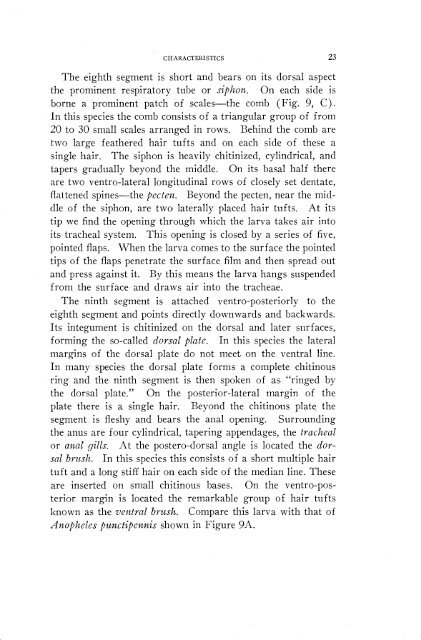a handbook of the mosquitoes of north america - Systematic Catalog ...
a handbook of the mosquitoes of north america - Systematic Catalog ...
a handbook of the mosquitoes of north america - Systematic Catalog ...
You also want an ePaper? Increase the reach of your titles
YUMPU automatically turns print PDFs into web optimized ePapers that Google loves.
CHARACTERISTICS 23<br />
The eighth segment is short and bears on its dorsal aspect<br />
<strong>the</strong> prominent respiratory tube or sipholz. On each side is<br />
borne a prominent patch <strong>of</strong> scales-<strong>the</strong> comb (Fig. 9, C).<br />
In this species <strong>the</strong> comb consists <strong>of</strong> a triangular group <strong>of</strong> from<br />
20 to 30 small scales arranged in rows. Behind <strong>the</strong> comb are<br />
two large fea<strong>the</strong>red hair tufts and on each side <strong>of</strong> <strong>the</strong>se a<br />
single hair. The siphon is heavily chitinized, cylindrical, and<br />
tapers gradually beyond <strong>the</strong> middle. On its basal half <strong>the</strong>re<br />
are two ventro-lateral longitudinal rows <strong>of</strong> closely set dentate,<br />
flattened spines-<strong>the</strong> pecten. Beyond <strong>the</strong> pecten, near <strong>the</strong> mid-<br />
dle <strong>of</strong> <strong>the</strong> siphon, are two laterally placed hair tufts. At its<br />
tip we find <strong>the</strong> opening through which <strong>the</strong> larva takes air into<br />
its tracheal system. This opening is closed by a series <strong>of</strong> five,<br />
pointed flaps. When <strong>the</strong> larva comes to <strong>the</strong> surface <strong>the</strong> pointed<br />
tips <strong>of</strong> <strong>the</strong> flaps penetrate <strong>the</strong> surface film and <strong>the</strong>n spread out<br />
and press against it. By this means <strong>the</strong> larva hangs suspended<br />
from <strong>the</strong> surface and draws air into <strong>the</strong> tracheae.<br />
The ninth segment is attached ventro-posteriorly to <strong>the</strong><br />
eighth segment and points directly downwards and backwards.<br />
Its integument is chitinized on <strong>the</strong> dorsal and later surfaces,<br />
forming <strong>the</strong> so-called dorsal plate. In this species <strong>the</strong> lateral<br />
margins <strong>of</strong> <strong>the</strong> dorsal plate do not meet. on <strong>the</strong> ventral line.<br />
In many species <strong>the</strong> dorsal plate forms a complete chitinous<br />
ring and <strong>the</strong> ninth segment is <strong>the</strong>n spoken <strong>of</strong> as “ringed by<br />
<strong>the</strong> dorsal plate.” On <strong>the</strong> posterior-lateral margin <strong>of</strong> <strong>the</strong><br />
plate <strong>the</strong>re is a single hair. Beyond <strong>the</strong> chitinous plate <strong>the</strong><br />
segment is fleshy and bears <strong>the</strong> anal opening. Surrounding<br />
<strong>the</strong> anus are four cylindrical, tapering appendages, <strong>the</strong> tracheal<br />
or aflu1 gills. At <strong>the</strong> postero-dorsal angle is located <strong>the</strong> dor-<br />
sal brush. In this. species this consists <strong>of</strong> a short multiple hair<br />
tuft and a long stiff hair on each side <strong>of</strong> <strong>the</strong> median line. These<br />
are inserted on small chitinous bases. On <strong>the</strong> ventro-pos-<br />
terior margin is located <strong>the</strong> remarkable group <strong>of</strong> hair tufts<br />
known as <strong>the</strong> rdentral brush. Compare this larva with that <strong>of</strong><br />
Anopheles pwctipenzis shown in Figure 9A.

















